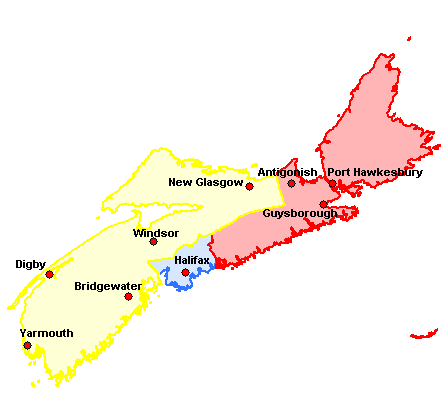Lakil (Lequille) – There is something very wrong with the way eligibility for EI is calculated. Many people in rural Nova Scotia are paying the price.
To be eligible for regular EI benefits, you must have worked between 420-700 hours in the previous year. The number of hours depends on the unemployment rate in your area.

In Nova Scotia there are only three such unemployment areas, an Eastern Zone, a Western Zone, and urban Halifax (see map). That causes all kinds of problems.
In Calgary you need fewer hours to qualify for Employment Insurance (EI) than you do in Pugwash, Nova Scotia. Yes, you read that correctly. In Calgary you need 630 hours to qualify for a basic 16 week EI claim; in Western Nova Scotia you need 665 hours for a basic 15 week claim.
This is because in Western Nova Scotia our unemployment rate is supposedly a record low 6.9%
“I simply don’t see the jobs”
What? I can’t remember ever seeing our unemployment rate here that low. Nor can I remember the hours needed to qualify for EI being so high.
What’s more, I simply don’t see the jobs! Where is this great employment shift upwards in our region? Talking with friends from all over the region, no one is seeing that huge swing in available jobs.
Recently I was in Clark’s Harbour, the most southern tip of Nova Scotia, talking with a group of people. I asked them “Is your community being affected by the new unemployment rate of 6.9%?” This opened up a huge discussion. “The lobstering wasn’t that good this year” one woman told me. “The fishermen are okay but those who work in the fish plants did not get enough hours for EI.”
Up in the Pictou region it is the same thing. But if you cross the county line over to Guysborough, the hours needed drop dramatically, to 420 hours needed for a 30 week claim.
What gives? Did someone in the Department of Employment and Social Development do their math incorrectly?
To add insult to injury, residents of the unemployment regions of both Eastern and Western Nova Scotia are entitled to an extra five weeks of EI if they are seasonal workers. There is a catch though. You must have been laid off at the same time each year. So those who were laid off early because of the lack of lobster will not qualify for the extra five weeks. The kicker of this is, however, the workers cannot even qualify for their basic EI because of the so-called high employment rate, let alone the extra five weeks.
All this made me wonder. We need to talk to our MPs about this. It’s not acceptable.
Minimum wage jobs and the invisible unemployed
What kind of jobs have seen such a big increase in our economic region? Are they decently paid, year round full time jobs? Or are they part time jobs that pay minimum wages and do not come with benefits? This area is rife with the latter kind of jobs.
I suspect that many unemployed people here have simply been rendered invisible.
If you cannot get Employment Insurance or have already run out of EI, you are no longer considered ‘unemployed’. This is because you are not on EI.
These workers in Western Nova Scotia have no money coming in. Some are now going to their local food banks. Others are borrowing money from family members. Many have turned to social assistance as they have run out of savings. But they do not count as unemployed under the unemployment calculations.
The Economic Region of Western Nova Scotia is too vast and doesn’t take into account the many micro employment areas it includes
And where are all these people with jobs? Do they live they close to Halifax, in the bedroom communities? Those of us who live in Annapolis Royal, Clark’s Harbour or River John are too far away to get to the jobs outside of Halifax.
The Economic Region of Western Nova Scotia is too vast and doesn’t take into account the many micro employment areas it includes; it does not consider the lack of transportation in rural Nova Scotia, the distance required to travel for jobs, the severity of weather conditions and the lack of highway maintenance in all seasons.
What gives with the EI rate in Western Nova Scotia? People are going hungry, Mr. Trudeau. Your team needs to do a serious re-assessment of how you calculate the employment rates and unemployment rates in this economic region and what you define as a ‘job’.
Talk to the people here. We’ll tell you.
Brenda Thompson is an activist and author who lives in the Annapolis Valley.
With a special thanks to our generous donors who make publication of the Nova Scotia Advocate possible.
Subscribe to the Nova Scotia Advocate weekly digest and never miss an article again. It’s free!




Amen to you Brenda,you are right, the hours here in Clark’s Harbour district are far to high,I have two part time seasonal jobs,and I barely get the required amount of hours each year,as a result of low lobster catches and the eel fisheries as well.
It’s hard to just blame the Federal Government, When our Premier, is spending 10.8 Million dollars on a Ferry, that can’t operate without Government, assistances and Nova Scotia, tax payers paying the wages of American, workers to maintain the Ferry, while tied up on the south of the border. And $3.8 million on a track and park in Bridgetown. Building a new flue for the birds to return to and know one knows if they will use the new Chimney or not like we can really afford this bullshit and know one can get a doctor or a clinic you have to drive to Berwick and hope you’re between 1 and 30 after that your shit out of luck.
And people wonder why our crime and theft rates are so high in western Nova Scotia 🙁
That’s pitiful when people from this area are so down and out